各种时态的被动语态
- 格式:ppt
- 大小:2.05 MB
- 文档页数:62
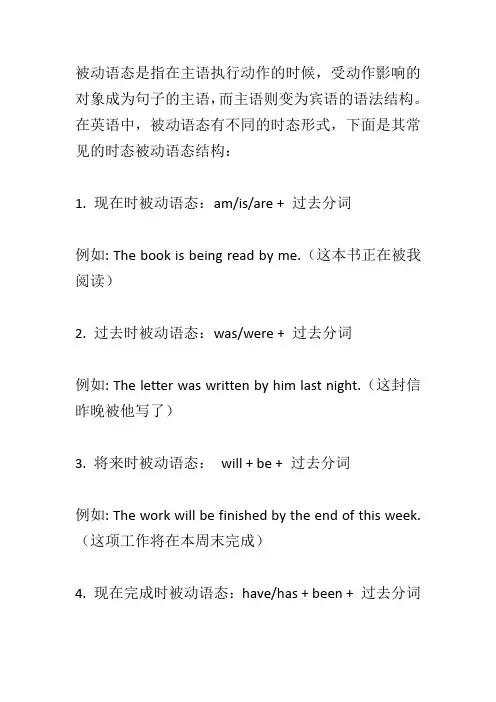
被动语态是指在主语执行动作的时候,受动作影响的对象成为句子的主语,而主语则变为宾语的语法结构。
在英语中,被动语态有不同的时态形式,下面是其常见的时态被动语态结构:
1. 现在时被动语态:am/is/are + 过去分词
例如: The book is being read by me.(这本书正在被我阅读)
2. 过去时被动语态:was/were + 过去分词
例如: The letter was written by him last night.(这封信昨晚被他写了)
3. 将来时被动语态:will + be + 过去分词
例如: The work will be finished by the end of this week.(这项工作将在本周末完成)
4. 现在完成时被动语态:have/has + been + 过去分词
例如: The house has been built for two months.(这幢房子已经建成两个月了)
5. 过去完成时被动语态:had + been + 过去分词
例如: The decision had been made by the committee before I arrived.(这个决定在我到达之前已经被委员会做出了)
注意,在使用被动语态时,主语变为宾语,谓语动词的过去分词形式放在be 动词后面。
同时,主语在句子中通常会被放在by 后面,表示动作执行的对象。
但有时候,by 短语也可以省略。
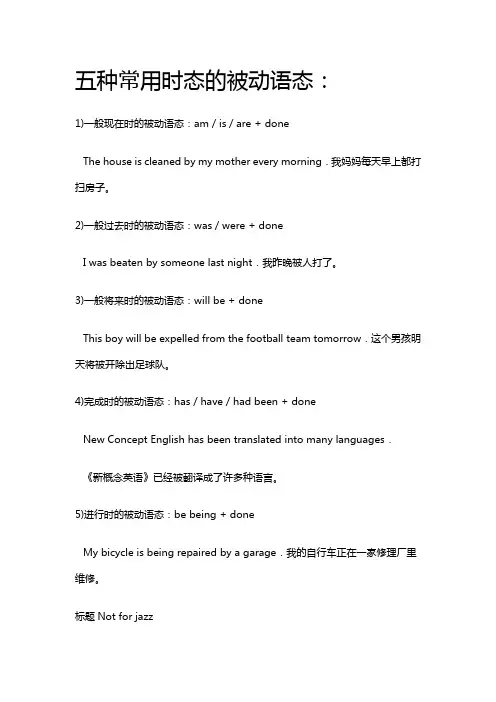
五种常用时态的被动语态:1)一般现在时的被动语态:am/is/are + doneThe house is cleaned by my mother every morning.我妈妈每天早上都打扫房子。
2)一般过去时的被动语态:was/were + doneI was beaten by someone last night.我昨晚被人打了。
3)一般将来时的被动语态:will be + doneThis boy will be expelled from the football team tomorrow.这个男孩明天将被开除出足球队。
4)完成时的被动语态:has/have/had been + doneNew Concept English has been translated into many languages.《新概念英语》已经被翻译成了许多种语言。
5)进行时的被动语态:be being + doneMy bicycle is being repaired by a garage.我的自行车正在一家修理厂里维修。
标题Not for jazz总结for的用法:1)为:I bought a book for you.我为你买了一本书。
2)因为:Something fell in,for I heard a splash.一定有东西掉下去了,因为我听见扑通一声。
4)适合:Not for jazz=It's not suitable to play jazz on the clavichord.古钢琴不适合演奏爵士乐。
Question:What happened to the clavichord?to后面加宾语,表示其身上发生了什么事,即动作的目标、对象。
What happened to you?你怎么了?(在你身上发生了什么事?)(1)否定句与疑问句的被动语态We don’t believe her.我们不信她的话。
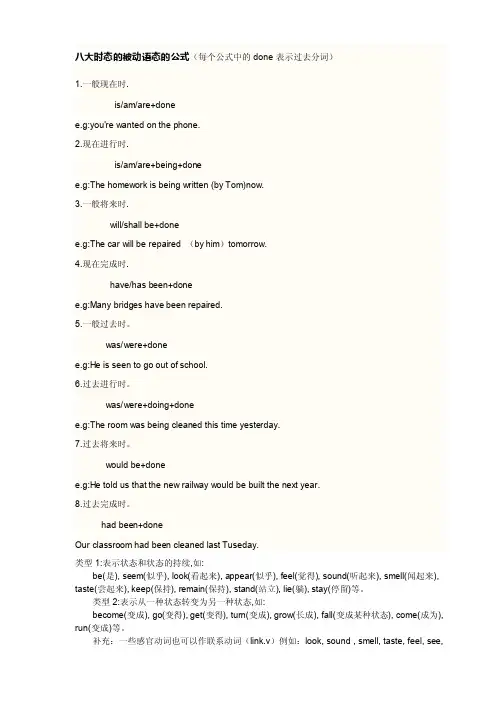
八大时态的被动语态的公式(每个公式中的done表示过去分词)1.一般现在时.is/am/are+donee.g:you're wanted on the phone.2.现在进行时.is/am/are+being+donee.g:The homework is being written (by Tom)now.3.一般将来时.will/shall be+donee.g:The car will be repaired (by him)tomorrow.4.现在完成时.have/has been+donee.g:Many bridges have been repaired.5.一般过去时。
was/were+donee.g:He is seen to go out of school.6.过去进行时。
was/were+doing+donee.g:The room was being cleaned this time yesterday.7.过去将来时。
would be+donee.g:He told us that the new railway would be built the next year.8.过去完成时。
had been+doneOur classroom had been cleaned last Tuseday.类型1:表示状态和状态的持续,如:be(是), seem(似乎), look(看起来), appear(似乎), feel(觉得), sound(听起来), smell(闻起来), taste(尝起来), keep(保持), remain(保持), stand(站立), lie(躺), stay(停留)等。
类型2:表示从一种状态转变为另一种状态,如:become(变成), go(变得), get(变得), turn(变成), grow(长成), fall(变成某种状态), come(成为), run(变成)等。
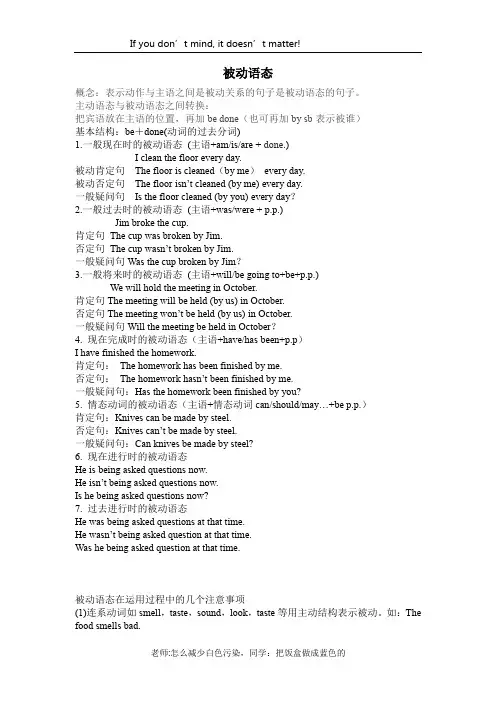
被动语态概念:表示动作与主语之间是被动关系的句子是被动语态的句子。
主动语态与被动语态之间转换:把宾语放在主语的位置,再加be done(也可再加by sb表示被谁)基本结构:be+done(动词的过去分词)1.一般现在时的被动语态(主语+am/is/are + done.)I clean the floor every day.被动肯定句The floor is cleaned(by me)every day.被动否定句The floor isn’t cleaned (by me) every day.一般疑问句Is the floor cleaned (by you) every day?2.一般过去时的被动语态(主语+was/were + p.p.)Jim broke the cup.肯定句The cup was broken by Jim.否定句The cup wasn’t broken by Jim.一般疑问句Was the cup broken by Jim?3.一般将来时的被动语态(主语+will/be going to+be+p.p.)We will hold the meeting in October.肯定句The meeting will be held (by us) in October.否定句The meeting won’t be held (by us) in October.一般疑问句Will the meeting be held in October?4. 现在完成时的被动语态(主语+have/has been+p.p)I have finished the homework.肯定句:The homework has been finished by me.否定句:The homework hasn’t been finished by me.一般疑问句:Has the homework been finished by you?5. 情态动词的被动语态(主语+情态动词can/should/may…+be p.p.)肯定句:Knives can be made by steel.否定句:Knives can’t be made by steel.一般疑问句:Can knives be made by steel?6. 现在进行时的被动语态He is being asked questions now.He isn’t being asked questions now.Is he being asked questions now?7. 过去进行时的被动语态He was being asked questions at that time.He wasn’t being asked question at that time.Was he being asked question at that time.被动语态在运用过程中的几个注意事项(1)连系动词如smell,taste,sound,look,taste等用主动结构表示被动。
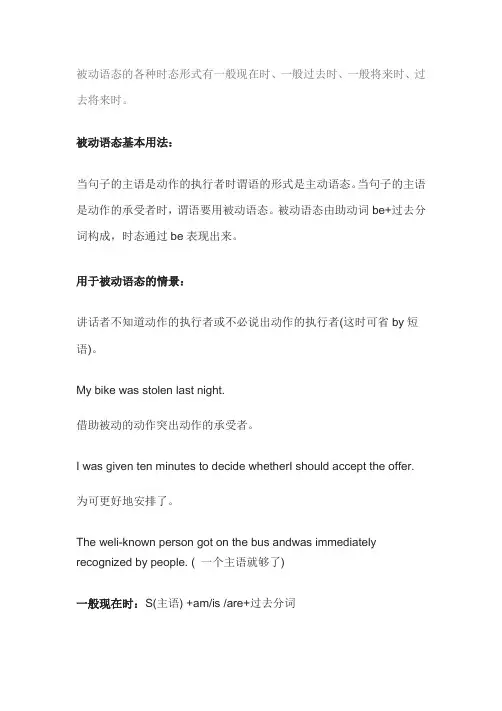
被动语态的各种时态形式有一般现在时、一般过去时、一般将来时、过去将来时。
被动语态基本用法:当句子的主语是动作的执行者时谓语的形式是主动语态。
当句子的主语是动作的承受者时,谓语要用被动语态。
被动语态由助动词be+过去分词构成,时态通过be表现出来。
用于被动语态的情景:讲话者不知道动作的执行者或不必说出动作的执行者(这时可省by短语)。
My bike was stolen last night.借助被动的动作突出动作的承受者。
I was given ten minutes to decide whetherI should accept the offer.为可更好地安排了。
The weli-known person got on the bus andwas immediately recognized by people. ( 一个主语就够了)一般现在时:S(主语) +am/is /are+过去分词We can see some pictures on the wall. 我们能看到墙上的画。
Is he always play the football with the classmates?他经常和朋友踢足球吗?Does she often talkwith you?她经常和你说话吗?Does he takes a long walk every nights?他经常饭后散步吗?He likes misic very much.他很喜欢音乐。
一般过去时:S+was/were +过去分词He played tennis last week.上星期他们打过网球。
I watched TV yesterday.我昨天看电视了。
I didn''t know you were in Paris.我不知道你在巴黎。
He didn’t have classes this morning.他今天上午没上课。
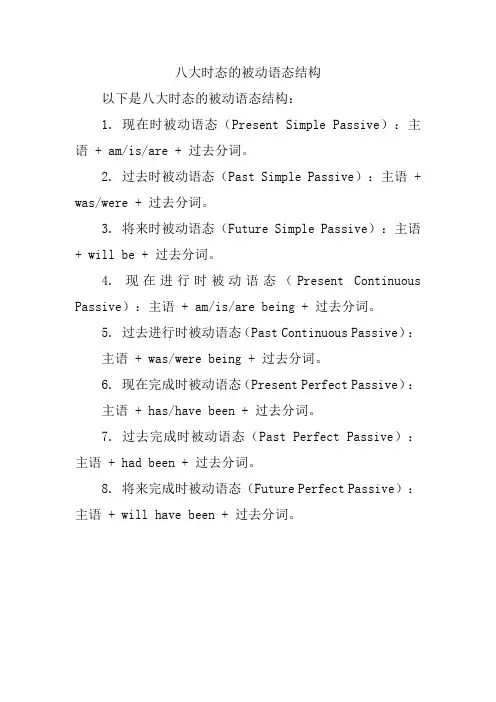
八大时态的被动语态结构
以下是八大时态的被动语态结构:
1. 现在时被动语态(Present Simple Passive):主语 + am/is/are + 过去分词。
2. 过去时被动语态(Past Simple Passive):主语 + was/were + 过去分词。
3. 将来时被动语态(Future Simple Passive):主语+ will be + 过去分词。
4. 现在进行时被动语态(Present Continuous Passive):主语 + am/is/are being + 过去分词。
5. 过去进行时被动语态(Past Continuous Passive):
主语 + was/were being + 过去分词。
6. 现在完成时被动语态(Present Perfect Passive):
主语 + has/have been + 过去分词。
7. 过去完成时被动语态(Past Perfect Passive):主语 + had been + 过去分词。
8. 将来完成时被动语态(Future Perfect Passive):主语 + will have been + 过去分词。
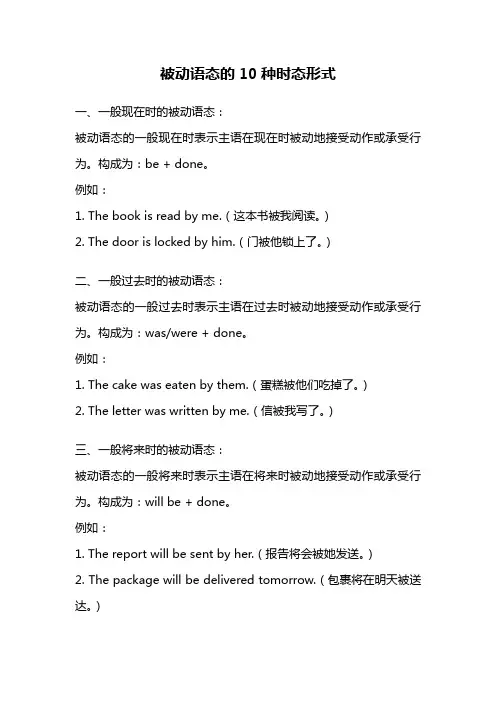
被动语态的10种时态形式一、一般现在时的被动语态:被动语态的一般现在时表示主语在现在时被动地接受动作或承受行为。
构成为:be + done。
例如:1. The book is read by me.(这本书被我阅读。
)2. The door is locked by him.(门被他锁上了。
)二、一般过去时的被动语态:被动语态的一般过去时表示主语在过去时被动地接受动作或承受行为。
构成为:was/were + done。
例如:1. The cake was eaten by them.(蛋糕被他们吃掉了。
)2. The letter was written by me.(信被我写了。
)三、一般将来时的被动语态:被动语态的一般将来时表示主语在将来时被动地接受动作或承受行为。
构成为:will be + done。
例如:1. The report will be sent by her.(报告将会被她发送。
)2. The package will be delivered tomorrow.(包裹将在明天被送达。
)四、现在进行时的被动语态:被动语态的现在进行时表示主语在现在进行时被动地接受动作或承受行为。
构成为:am/is/are being + done。
例如:1. The car is being washed by the workers.(汽车正在被工人清洗。
)2. The project is being discussed by the team.(项目正在被团队讨论。
)五、过去进行时的被动语态:被动语态的过去进行时表示主语在过去进行时被动地接受动作或承受行为。
构成为:was/were being + done。
例如:1. The house was being renovated last month.(房子上个月正在进行装修。
)2. The document was being translated by the intern.(文件正在被实习生翻译。

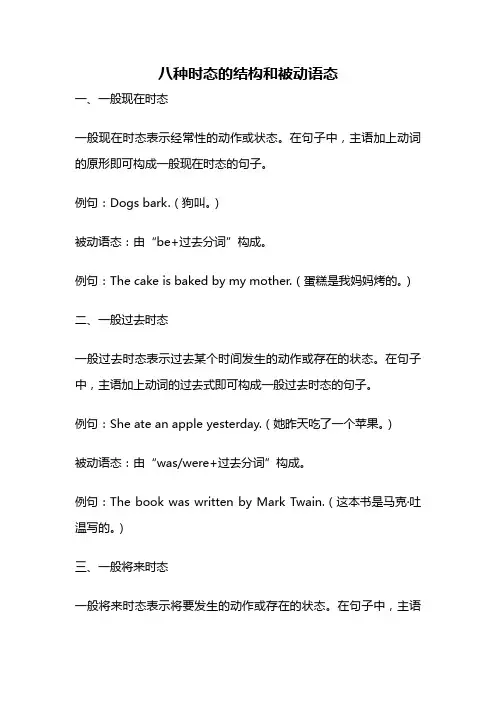
八种时态的结构和被动语态一、一般现在时态一般现在时态表示经常性的动作或状态。
在句子中,主语加上动词的原形即可构成一般现在时态的句子。
例句:Dogs bark.(狗叫。
)被动语态:由“be+过去分词”构成。
例句:The cake is baked by my mother.(蛋糕是我妈妈烤的。
)二、一般过去时态一般过去时态表示过去某个时间发生的动作或存在的状态。
在句子中,主语加上动词的过去式即可构成一般过去时态的句子。
例句:She ate an apple yesterday.(她昨天吃了一个苹果。
)被动语态:由“was/were+过去分词”构成。
例句:The book was written by Mark Twain.(这本书是马克·吐温写的。
)三、一般将来时态一般将来时态表示将要发生的动作或存在的状态。
在句子中,主语加上助动词“will”或“shall”,再加上动词的原形即可构成一般将来时态的句子。
例句:I will visit my grandparents next week.(我下周会去看望我的祖父母。
)被动语态:由“wil l be+过去分词”或“is/am/are going to be+过去分词”构成。
例句:The letter will be delivered by the postman.(这封信将由邮递员投递。
)四、现在进行时态现在进行时态表示现在正在进行的动作。
在句子中,主语加上“be”动词的现在分词形式,再加上动词的原形即可构成现在进行时态的句子。
例句:She is watching TV now.(她正在看电视。
)被动语态:由“am/is/are being+过去分词”构成。
例句:The house is being cleaned by the maid.(房子正在被女仆打扫。
)五、过去进行时态过去进行时态表示过去某个时间正在进行的动作。
在句子中,主语加上“was/were”动词的现在分词形式,再加上动词的原形即可构成过去进行时态的句子。

各种时态的被动语态一、八大时态的被动语态的构成:1.一般现在时的被动语态构成:(am/is/are +done)如:I am asked to study hard. 我被请求努力学习。
This shirt is washed once a week. 这件T恤一周洗一次。
These songs are usually sung by boys. 这些歌曲通常是男生唱的。
2.一般过去时的被动语态构成:(was/were done)如:The soldier was killed, but the train was saved. 这位战士牺牲了,然而列车得救了。
Some notes were passed up to the speaker. 有人给讲演者递上来一些纸条。
3.一般将来时的被动语态构成:(shall/will be done)如:We shall be asked a lot of strange questions. 我们将被问许多怪题。
My son will be sent to school next September. 来年九月我将送我儿子去读书。
4.过去将来时的被动语态构成:(should/would be done)如:The news would be sent to him as soon as it arrived. 消息一到就会转给他的。
He told us that the new railway would be built the next year. 他告诉我新铁路将在明年修建。
5.现在完成时的被动语态构成:(has/have been done)如:The work has just been finished. 工作刚刚结束。
The old rules have been done away with by us. 旧规章已经被我们废除了。
6.过去完成时的被动语态构成:(had been done)如:By last December three ships had been built by them. 到去年十二月底他们已建造了三艘船。
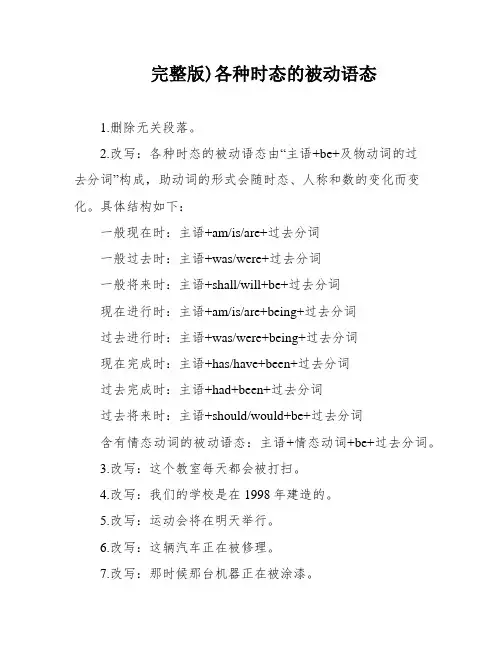
完整版)各种时态的被动语态1.删除无关段落。
2.改写:各种时态的被动语态由“主语+be+及物动词的过去分词”构成,助动词的形式会随时态、人称和数的变化而变化。
具体结构如下:一般现在时:主语+am/is/are+过去分词一般过去时:主语+was/were+过去分词一般将来时:主语+shall/will+be+过去分词现在进行时:主语+am/is/are+being+过去分词过去进行时:主语+was/were+being+过去分词现在完成时:主语+has/have+been+过去分词过去完成时:主语+had+been+过去分词过去将来时:主语+should/would+be+过去分词含有情态动词的被动语态:主语+情态动词+be+过去分词。
3.改写:这个教室每天都会被打扫。
4.改写:我们的学校是在1998年建造的。
5.改写:运动会将在明天举行。
6.改写:这辆汽车正在被修理。
7.改写:那时候那台机器正在被涂漆。
8.改写:这家银行已经建成了。
9.改写:在我来这里之前,我已经被邀请去日本访问了。
10.改写:XXX告诉我她将会被派往美国。
11.改写:这辆自行车不能放在这里。
I XXX invited so far。
so I'm not sure。
The government in our country will now record tourists' bad r。
It is XXX。
Special passive voice forms:1.When a sense verb (XXX) or a causative verb(make/let/have) is followed by an infinitive without "to" in an active sentence。
the "to" should be added in a passive sentence。
●一般现在时及其被动语态一般现在时:V含单三被动:be= be●一般过去时及其被动语态一般过去时:V-ed被动; be= was/were●一般将来时及其被动语态一般将来时:will/shall Vr 被动:be = will/shall be●现在进行时及其被动语态现在:V进行:be V-ing现在进行时:be V-ing被动:be= be being●现在完成时及其被动语态现在:V完成时:have/has现在完成时:have/has被动:be= have/has been●现在完成进行时及其被动语态现在:V完成:have/has进行:be V-ing 现在完成进行时:have/has been V-ing 被动:be= have/has been being●过去进行时及其被动语态过去:V-ed进行:be V-ing过去进行时:was/were V-ing被动:be= was/were being●过去完成时及其被动语态过去:V-ed完成:have/has过去完成时:had被动:be= had been●过去完成进行时及其被动语态过去:V-ed完成:have/has进行:be V-ing 过去完成进行时:had been V-ing 被动:be = had been being●将来进行时及其被动语态将来:will/shall Vr进行:be V-ing将来进行时:will/shall be V-ing 被动:be= will/shall be being●将来完成时及其被动语态将来:will/shall Vr完成:have/has---------------------------------------------------------将来完成时:will/shall have被动:be= will/shall have been●将来完成进行时及其被动态将来:will/shall Vr完成; have/has进行:be V-ing 将来完成进行时:will/shall have been V-ing 被动:be= will have been being●过去将来时及其被动语态过去:V-ed将来:will/would Vr过去将来时:would Vr被动:be= would be●过去将来进行时及其被动语态过去:V-ed将来:will/shall Vr进行:be V-ing过去将来进行时:would be V-ing被动:be= would be being●过去将来完成时及其被动语态过去:V-ed将来:will/shall Vr完成:have/has---------------------------------------------------------过去将来完成时:would have被动:be= would have been●过去将来完成进行时及其被动语态过去时:V-ed将来时:will Vr完成时:have进行时:be V-ing--------------------------------------------------------过去将来完进行时:would have been V-ing被动:be= would have been being。
被动语态的10种时态形式一、一般现在时的被动语态被动语态的一般现在时形式是由助动词“am/is/are”加上动词的过去分词构成。
在句子中,一般现在时的被动语态常用来描述客观事实或普遍规律。
例如:1. 苹果被人们广泛种植和消费。
2. 好书常常被人们珍藏。
二、一般过去时的被动语态被动语态的一般过去时形式是由助动词“was/were”加上动词的过去分词构成。
一般过去时的被动语态常用于描述过去发生的被动动作或状态。
例如:1. 这个城市在20年前被建立。
2. 大象被人们奉为神圣动物。
三、一般将来时的被动语态被动语态的一般将来时形式是由助动词“will be”加上动词的过去分词构成。
一般将来时的被动语态常用于表示将来某个时间点或某个事件发生时将会受到的被动影响或动作。
例如:1. 这个问题将会被专家们讨论和解决。
2. 明天的比赛将会被全国观众关注。
四、现在进行时的被动语态被动语态的现在进行时形式是由助动词“am/is/are being”加上动词的过去分词构成。
现在进行时的被动语态常用于描述当前正在进行的被动动作。
例如:1. 这个项目正在被我们团队进行。
2. 正在播放的电影是由著名导演执导的。
五、过去进行时的被动语态被动语态的过去进行时形式是由助动词“was/were being”加上动词的过去分词构成。
过去进行时的被动语态常用于描述过去某个时间点正在进行的被动动作。
例如:1. 那个时候,这个城市正在被大规模改造。
2. 学生们在考试时都被要求保持安静。
六、将来进行时的被动语态被动语态的将来进行时形式是由助动词“will be being”加上动词的过去分词构成。
将来进行时的被动语态常用于描述将来某个时间点正在进行的被动动作。
例如:1. 明天这个时间段,这个工程将会被施工人员进行。
2. 下个月这个时候,我们将会被送到目的地。
七、现在完成时的被动语态被动语态的现在完成时形式是由助动词“have/has been”加上动词的过去分词构成。
动词的语态:主动语态和被动语态被动语态的基本结构:Be + done(过去分词)1、一般现在时:(主动语态)I help you.发出者动词承受者变为被动语态:Do——am/is/are doneYou are helped by me.承受者谓语发出者2、一般过去时的被动:did——was/were done(I helped you.-每个例子可让学生自己先尝试变被动,再给答案)3、一般将来时的被动:Will do——will be done(I will help you.-)4、现在进行时的被动:Am/is/are doing ——Am/is/are being done(I am helping you.-)5、过去进行时的被动:Was/were doing——Was/were being done(I was helping you.-)6、现在完成时的被动:Have done——have been done (I have helped you.-)7、过去完成时的被动:Had done——had been done (I had helped you.-)8、过去将来时的被动:Would do ——would be done (I would help you.-)答案:2、You were helped by me.3、You will be helped by me.4、You are being helped by me.5、You were being helped by me.6、You have been helped by me.7、You had been helped by me.8、You would be helped by me.。
被动语态在各时态中的变化被动语态是英语中的一种语法结构,用于表示主语是动作的接受者,而不是执行者。
在不同的时态下,被动语态的构造和变化会有所不同。
本文将就被动语态在各时态中的变化进行详细讨论。
一、一般现在时的被动语态一般现在时的被动语态由助动词“am/is/are”+过去分词构成。
它被用于表示动作在现在被执行或经常被执行的情况下。
例如:主动语态:They deliver the products.(他们交付产品。
)被动语态:The products are delivered by them.(产品被他们交付。
)二、一般过去时的被动语态一般过去时的被动语态由助动词“was/were”+过去分词构成。
它用于表示过去某一事件或动作的被动形式。
例如:主动语态:He repaired the car.(他修理了汽车。
)被动语态:The car was repaired by him.(汽车被他修理了。
)三、一般将来时的被动语态一般将来时的被动语态由助动词“will be”+过去分词构成。
它表示将来某一事件或动作的被动形式。
例如:主动语态:They will complete the project.(他们将完成这个项目。
)被动语态:The project will be completed by them.(这个项目将被他们完成。
)四、现在进行时的被动语态现在进行时的被动语态由助动词“am/is/are”+being+过去分词构成。
它表示现在某一事件或动作正在被执行。
例如:主动语态:She is writing the report.(她正在写报告。
)被动语态:The report is being written by her.(报告正在被她写。
)五、过去进行时的被动语态过去进行时的被动语态由助动词“was/were”+being+过去分词构成。
它表示过去某一事件或动作正在被执行。
例如:主动语态:They were building the house.(他们在建房子。
五种时态的被动语态英语的语态分为主动语态和被动语态两种。
被动语态表示主语是动作的承受者。
被动语态由“助动词be+过去分词” 构成。
在这里重点复习已经学习过的一般现在时、一般过去时、一般将来时、现在完成时和过去完成时五种被动语态。
其时态构成如下表:注意:被动语态有时可用“get+过去分词”结构来表示,强调动作的结果。
如:He got injured while playing football.他在踢球时受了伤。
被动语态的使用场合: ①动作谁做的不知道;②说出谁做的没必要;③动作承受者需强调。
另外,除上述之外,还有现在/过去进行时、过去将来时、将来完成时和其它特殊形式的被动语态,我们将在以后的模块中学习。
【高考链接】1. As the years passed, many occasions—birthdays, awards, graduations—_______ with Dad’s flowers. (2007湖南)A. are markedB. were markedC. have markedD. had marked2. At the end of the meeting, it was announced that an agreement _________.A. has been reachedB. had been reached (2007江苏)C. has reachedD. had reached3. The flowers were so lovely that they __________ in no time. (2007全国I)A. soldB. had been soldC. were soldD. would sell4. I got caught in the rain and my suit__________. (2007北京)A. has ruinedB. had ruinedC. has been ruinedD. had been ruined5. With the help of high technology, more and more new substances ______ in the past years. (2007上海)A. discoveredB. have discoveredC. had been discoveredD. have been discoveredKey: BBCCD【练练看】1. Professor James will give us a lecture on the Western culture, but when and where ____ yet.A. hasn’t been decidedB. haven’t decidedC. isn’t being decidedD. aren’t decided2. Months ago we sailed ten thousand miles across this open sea,which ______ the Pacific,and we met no storms.A. was calledB. is calledC. had been calledD. has been called3. — Y our job ________ open for your return.—Thanks.A. will be keptB. will keepC. had keptD. had been kept4. The construction of the two new railway lines__________ by now.A. has completedB. have completedC. have been completedD. has been completed5. John had to have his car repaired in a garage because it_________ seriously.A. damagedB. was being damagedC. had damagedD. had been damaged6. I'll have to push the car to the side of the road because we ____ if we leave it here.A. would be finedB. will be finedC. will being finedD. will have been fined7. A great number of colleges and universities ____ since 1949.A. had establishedB. have been establishedC. have establishedD. had been established8. My pictures ____ until next Friday.A. won't developB. aren't developedC. don't developD. won' t be developed9. She will stop showing off if no notice ____ of her.A. is takenB. takesC. will be takenD. has taken10. We are late. I expect the film ____ by the time we get to the cinema.A. will already have startedB. would already have startedC. shall have already startedD. has already been startedKey: 1-5 ABADD 6-10 BBDAA。